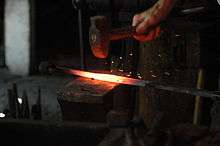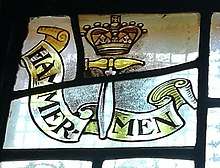Robert Garnock
Robert Garnock (c. 1660 – 1681) was a Scottish covenanter.[1] He was baptised by James Guthrie and like him was hanged in Edinburgh although at a different time and place;[2] Guthrie was executed about 20 years before Garnock.[3]
Robert Garnock | |
|---|---|
 Stirling Hammerman | |
| Personal | |
| Religion | Christianity |
| School | Presbyterianism |

.jpg)
Early life
Garnock was a native of Stirling, the son of a blacksmith there. He followed the same occupation. He is known to have been paid for a sluice which formed part of the defences of the town.[4] After the restoration of episcopacy in Scotland in 1662, Garnock frequented the presbyterian conventicles. Being required in 1678 to take arms on behalf of the government, he declined, and was obliged to leave Stirling to avoid imprisonment. He went to Glasgow, Falkirk, Bo'ness and other towns, pursuing his calling as he could find opportunity; but, returning to Stirling, took part in a skirmish with dragoons at Ballyglass, near Fintry, on 18 May 1679.[2][5][6] This took place at one of Archibald Riddle's conventicles.[2] Unknown to the soldiers several of Archbishop Sharp's killers were present at the conventicle.[7]
Capture and imprisonment
On attempting to re-enter Stirling after the fight he was apprehended and thrown into prison, where he lay until in July following he was removed with a number of other prisoners to Edinburgh, and confined in the Greyfriars churchyard. Here in a small walled-in piece of ground nearly fifteen hundred prisoners were strictly warded, most of whom had been taken after the battle of Bothwell, and among these Garnock exerted himself to prevent them taking the 'test.'[8]
Trial
He was removed on 25 October for judicial examination, and, on declining to answer certain incriminatory questions, was incarcerated in the Tolbooth of Edinburgh. Here he remained, refusing all overtures for compliance, until 7 October 1681, when he was tried before the privy council, and for declining the king's authority was found guilty of treason, and condemned to be executed along with some of his fellows on the 10th of the same month.[8]
Last speech, execution and burial
.jpg)
The sentence was carried out at the Gallowlee, between Edinburgh and Leith, his head and hands being cut off and placed on spikes at the Pleasance port of the town. The bodies of Garnock and his fellow-sufferers were buried at the foot of the gibbet, but during the night they were removed by James Renwick and some friends, and reinterred in the West Church burying-ground of Edinburgh. They also took down the heads of Garnock and the others, in order to place them beside their bodies. But, the day dawning before this could be accomplished, they were compelled to bury them in the garden of a favourer of their cause, named Tweedie, in Lauriston, where in 1728 they were accidentally discovered and interred with much honor in Greyfriars churchyard, near the Martyrs' Tomb.[9] When in prison Garnock wrote an account of his life, from the manuscript of which John Howie, in his ‘Biographia Scoticana, or Scots Worthies,’ gives several extracts. His dying testimony is printed at length in the ‘Cloud of Witnesses’.[8][10]
References
- Citations
- Wells 2004.
- Jardine 2011.
- Shearer 1897.
- Ronald 1899.
- Kirkton 1817, p. 431.
- Howie & Carslaw 1870, p. 461-462.
- Smith 1896, p. 13-14.
- Paton 1890, p. 10-11.
- Walker & Hay 1901, p. 324-325.
- Thomson 1871.
- Sources
- Crookshank, William (1812). The history of the state and sufferings of the Church of Scotland, from the restoration to the revolution : with an introduction containing the most remarkable occurrences relating to that church from the Reformation to the restoration. Edinburgh: Thomas Turnbull. pp. 38, 101. Retrieved 27 July 2019.CS1 maint: ref=harv (link)
- Fairley, John A. (1916). The Book of the Old Edinburgh Club. 8. Edinburgh: T. and A. Constable for the members of the club. p. 117. Retrieved 27 July 2019.CS1 maint: ref=harv (link)
- Hewison, James King (1913a). The Covenanters. 1 (Revised and Corrected ed.). Glasgow: John Smith and son. Retrieved 22 July 2019.CS1 maint: ref=harv (link)
- Hewison, James King (1913b). The Covenanters. 2. Glasgow: John Smith and son. Retrieved 22 July 2019.CS1 maint: ref=harv (link)
- Howie, John; Carslaw, W. H. (1870). "Robert Garnock". The Scots worthies. Edinburgh: Oliphant, Anderson, & Ferrier. pp. 457–475.CS1 maint: ref=harv (link)

- Jardine, Mark (8 December 2011). "A most obstinate and malicious person': Robert Garnock, the Covenanters and the Croune of London". Jardine's Book of Martyrs. Retrieved 27 July 2019.CS1 maint: ref=harv (link)
- Johnston, John C (1887). favorite texts Treasury of the Scottish covenant. Edinburgh: Andrew Elliot. p. 598. Retrieved 27 July 2019.CS1 maint: ref=harv (link)
- Kirkton, James (1817). The secret and true history of the church of Scotland from the Restoration to the year 1678. Edinburgh: J. Ballantyne. pp. 431–432. Retrieved 18 July 2019.CS1 maint: ref=harv (link)
- Paton, Henry (1890). "Garnock, Robert". In Stephen, Leslie; Lee, Sidney (eds.). Dictionary of National Biography. 21. London: Smith, Elder & Co.CS1 maint: ref=harv (link)

- Ronald, James (1899). Landmarks of Old Stirling. Stirling: E. Mackay. p. 224. Retrieved 10 July 2019.CS1 maint: ref=harv (link)
- Shearer, John Elliot (1897). Shearer's Stirling : historical and descriptive, with extracts from Burgh records and Exchequer Roll volumes, 1264 to 1529, view of Stirling in 1620, and an old plan of Stirling. Stirling: R.S. Shearer & Son. p. 47. Retrieved 14 April 2017.CS1 maint: ref=harv (link)
- Smellie, Alexander (1903). "Two Octobers". Men of the Covenant : the story of the Scottish church in the years of the Persecution (2 ed.). New York: Fleming H. Revell Co. pp. 111–114. Retrieved 11 July 2019.CS1 maint: ref=harv (link)
- Smith, John Guthrie (1896). Strathendrick, and its inhabitants from early times. An account of the parishes of Fintry, Balfron, Killearn, Drymen, Buchanan, and Kilmarnock. Glasgow: James Maclehose and Sons. p. 13. Retrieved 27 July 2019.CS1 maint: ref=harv (link)
- Thomson, John Henderson (1871). "Robert Garnock". A cloud of witnesses, for the royal prerogatives of Jesus Christ : being the last speeches and testimonies of those who have suffered for the truth in Scotland, since the year 1680. Edinburgh: Oliphant, Anderson, & Ferrier. pp. 190–200. Retrieved 21 July 2019.CS1 maint: ref=harv (link)
- Walker, Patrick; Fleming, David Hay (1901). Six saints of the Covenant; Peden: Semple: Welwood: Cameron: Cargill: Smith. 2. London: Hodder and Stoughton. pp. 1–62. Retrieved 12 July 2019.CS1 maint: ref=harv (link)
- Wells, Vaughan T. (23 September 2004). "Garnock, Robert (c. 1660-1681), covenanter". Oxford Dictionary of National Biography (online ed.). oxfordindex.oup.com. doi:10.1093/ref:odnb/10401. Retrieved 5 October 2014.CS1 maint: ref=harv (link) (Subscription or UK public library membership required.)
- Wodrow, Robert; Burns, Robert (1828). The history of the sufferings of the church of Scotland from the restoration to the revolution, with an original memoir of the author, extracts from his correspondence, and preliminary dissertation. 3. Glasgow: Blackie, Fullarton & co., and Edinburgh: A. Fullarton & co. pp. 130, 176, 286–287. Retrieved 7 April 2019.CS1 maint: ref=harv (link)
- Attribution
![]()
External links
- "Garnock, Robert". Oxford Dictionary of National Biography (online ed.). Oxford University Press. doi:10.1093/ref:odnb/10401. (Subscription or UK public library membership required.)
- The Life of Mr. Robert Garnock.